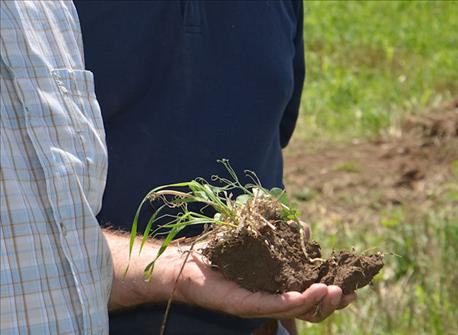The soil that is in Barry Fisher's hand in the picture is worth a thousand words. Fisher, regional manager of the new Soil Health initiative with the Natural Resources Conservation Service, hold soil from cover crop demonstration plots. The field where the plots were located has been in no-till and some form of cover crop for the past several years.
Related: Take a walk through cover crops, see what you can learn
Roger Wenning, Greensburg, standing to the right of Fisher, farms the land and has experimented with cover crops for years. He holds field days every year to show others what he has been able to do through combining cover crops with no-till.
Hold soil health? Maybe you really can't hold soil health in your hand, but Barry Fisher, left, and Roger Wenning, right, believe this soil is much healthier because Wenning uses no-till and cover crops.
Fisher was holding this particular soil because he wanted others to see how crumbly it was, and how loose and friable it was. That's the kind of change you can expect in soils if you concentrate on practices that allow soil health to recover after years of continuous tillage, Fisher relates.
Wenning demonstrated a number of different cover crops and cover crop mixtures. Cover crops are available that can capture nitrogen left behind from the season, that can produce nitrogen as legumes through nodules on roots so that there is nitrogen for next year's crop and that can send roots deep into the soil, loosening it for next year's crop roots.

Mixtures of up to 12 different cover crops can accomplish several things at once, Wenning notes. The trick is to know why you are adding each one to the mix, and not just add them to be doing so. He notes that you may also want to alter the mix depending upon the crop you intend to plant the next season. Cereal rye is popular for planting ahead of soybeans because it appears to help on weed control.
All cover crops also do one thing worth putting a value on, Fisher insists. Yes, they improve soil health over time. But they also help prevent future erosion by holding soil in place over the winter months when fields are traditionally bare.
Thinking about a cover crop? Start with developing a plan. Download the FREE Cover Crops: Best Management Practices report today, and get the information you need to tailor a cover crop program to your needs.
About the Author(s)
You May Also Like




